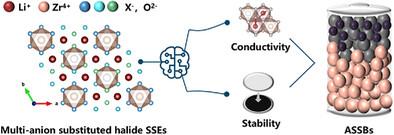Deciphering Key Features Determining Electrochemical Stability and Conductivity of Halide Solid-State Electrolytes
IF 19
1区 材料科学
Q1 CHEMISTRY, MULTIDISCIPLINARY
引用次数: 0
Abstract
Halide solid-state electrolytes (HSSEs) are promising electrolytes for all-solid-state batteries (ASSBs), benefiting from their high ionic conductivity and compatibility with high-voltage cathodes. However, HSSEs exhibit poor interfacial stability against anodes (such as lithium (Li) metal and Li alloys), and interlayers are commonly introduced to circumvent the interfacial instability, which would reduce the overall energy density. Meanwhile, the underlying factors governing the stability of HSSEs against anodes remain poorly understood. Herein, key predictors of stability against anodes and ionic conductivity are identified using a series of LiaZrClbOcBrdFe (LZOXs) solid-state electrolytes through multi-anion substitution and chemistry-informed machine learning. As a result, the optimal composition, Li2ZrCl4.4O0.4Br0.4F0.4 (LZOX) enables 1500 h of stable cycling in LiAl symmetric cells and achieves 200 cycles at 0.5 C and 600 cycles at 2 C in LiCoO2 ASSBs without anode interlayers, effectively doubling the cycling life. More importantly, chemistry-informed machine learning deciphers key features—especially electronegativity for interfacial stability and cationic polarization for ionic conductivity—in the design of HSSEs, offering a strategy to develop HSSEs with enhanced compatibility toward high-performance ASSBs.

破译决定卤化物固态电解质电化学稳定性和电导率的关键特征
卤化物固态电解质(hsse)是全固态电池(assb)的有前途的电解质,得益于其高离子电导率和与高压阴极的兼容性。然而,hss对阳极(如锂(Li)金属和锂合金)的界面稳定性较差,通常引入中间层来规避界面不稳定性,这将降低总能量密度。同时,控制hss对阳极稳定性的潜在因素仍然知之甚少。在这里,通过多阴离子取代和化学信息机器学习,使用一系列LiaZrClbOcBrdFe (LZOXs)固态电解质确定了对阳极稳定性和离子电导率的关键预测因子。结果表明,优化的Li2ZrCl4.4O0.4Br0.4F0.4 (LZOX)在LiAl对称电池中可实现1500 h的稳定循环,在无阳极中间层的LiCoO2 assb中可实现0.5 C下200次循环和2 C下600次循环,有效地提高了循环寿命。更重要的是,化学信息的机器学习在hss设计中破译了关键特征,特别是界面稳定性的电负性和离子电导率的阳离子极化,为开发具有增强高性能assb兼容性的hss提供了一种策略。
本文章由计算机程序翻译,如有差异,请以英文原文为准。
求助全文
约1分钟内获得全文
求助全文
来源期刊

Advanced Functional Materials
工程技术-材料科学:综合
CiteScore
29.50
自引率
4.20%
发文量
2086
审稿时长
2.1 months
期刊介绍:
Firmly established as a top-tier materials science journal, Advanced Functional Materials reports breakthrough research in all aspects of materials science, including nanotechnology, chemistry, physics, and biology every week.
Advanced Functional Materials is known for its rapid and fair peer review, quality content, and high impact, making it the first choice of the international materials science community.
 求助内容:
求助内容: 应助结果提醒方式:
应助结果提醒方式:


